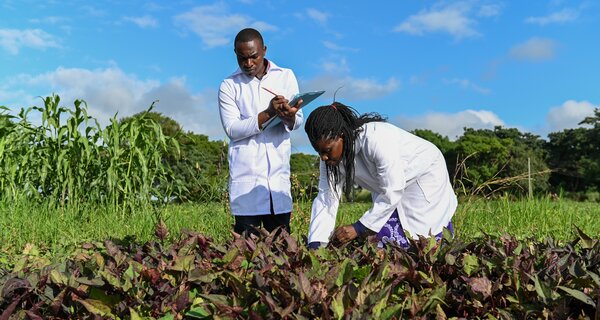Saving Sweetpotato Diversity: How Technology is Boosting Food Security in Drought-Affected Africa

2 October 2024
Sweetpotato plays a crucial role in combating food insecurity and malnutrition in Africa. However, its genetic diversity is under threat from climate change, pests, and diseases, which could have dire consequences for millions of people. Preserving sweetpotato diversity is essential to ensure future generations can benefit from this vital staple crop, especially in regions where food insecurity is widespread.
In Madagascar, for instance, malnutrition affects over half of children under two, largely due to food shortages exacerbated by droughts and frequent cyclones. In Zambia, severe droughts have also significantly harmed agricultural output, leaving farmers struggling. The Sweetpotato Project, now in its third year, has been tackling these challenges in partnership with communities in both countries. Funded by the Darwin Initiative and the Crop Trust, the project works alongside the International Potato Center (CIP), the Zambia Agricultural Research Institute (ZARI), and Fiompiana Fambolena Malagasy Norvéziana (FIFAMANOR) in Madagascar.
The project aims to preserve sweetpotato diversity through cryopreservation, which involves freezing plant shoot tips at ultra-low temperatures using liquid nitrogen. This technology is crucial to safeguard the diversity of sweetpotato and other crops that can’t be conserved as seeds. Launched in June 2022 as part of the Global Plant Cryopreservation Initiative, the project’s “Clean and Share” approach ensures that unique sweetpotato landraces are collected, cleaned of diseases and shared with farmers. They are also backed up with cryopreservation for use by future generations.

In Madagascar, farmers in five regions have helped identify and collect local landraces. Over the past year, the project has multiplied 10,000 vines from 22 landraces. Once cleaned, disease-free vines are shared back with farmers, increasing productivity and helping provide more nutritious food for vulnerable populations.
“The cleaning of the sweetpotato landraces from viral diseases, and the sharing of the purified vines with the population, will enhance the productivity of sweetpotato farmers and help fight food insecurity,” says Noroseheno Ralisoa, the project’s principal partner from FIFAMANOR.
In Zambia, with the help of community leaders, the project has distributed 46,200 vines from 16 landraces to 60 farmers across four drought-affected districts. This improves crop yields and helps restore genetic diversity lost to climate change, increasing food security and raising household incomes while reducing poverty.
“Restoring the genetic diversity of these landraces leads to incremental areas under sweetpotato cultivation each growing season,” says Graybill Munkombwe, principal agriculture research officer at ZARI. “This will ultimately improve the wellbeing of the target communities significantly.”
By involving local communities and focusing on gender equity – with women comprising over 60% of the farmers involved in Zambia – the Sweetpotato Project ensures that its interventions are sustainable and inclusive. The project also works to overcome cultural challenges, such as farmers’ hesitation to share their landraces, by explaining the long-term benefits of cryopreservation and securing their informed consent.
Global collaboration underpins the project. Vines collected from landraces in Madagascar and Zambia are sent to CIP’s facility in Nairobi for disease cleaning through meristem culture and heat treatment. Afterward, disease-free plants are returned to local partners for distribution to farmers, while other samples are cryopreserved at the CIP genebank in Lima, Peru.
“The long-term conservation of the landraces in CIP genebanks is a guarantee to farmers that these lines can be repatriated to them whenever needed,” says David Ellis, scientist emeritus at CIP.
So far, the project has collected 75 landraces from Madagascar and 260 from Zambia, which are now in long-term conservation. Once confirmed to be disease-free by CIP in Lima, these resources are made available for research, breeding and training worldwide under the terms of the International Plant Treaty. “The project’s second-year results are testament to the power of collaboration between multiple partners located in four countries,” says Sarada Krishnan, director of programs at the Crop Trust. “In spite of the challenges, sweetpotato farmers in Madagascar and Zambia today are better placed to deliver food security and boost their own livelihoods than they were a year ago.”
As the project continues, it is helping to improve food security, addressing malnutrition in Madagascar, and supporting drought-affected farmers in Zambia. The Sweetpotato Project is set to conclude by April 2025, but its impact will be felt for years to come as sweetpotato diversity is conserved for future generations, both in the fields of African farmers and far away in a lab in Peru.
Categories: For The Press, For Partners, The Sweetpotato Project, Sweetpotato, Environmental Restoration, Nutritional Security, Poverty Reduction



